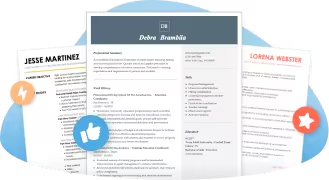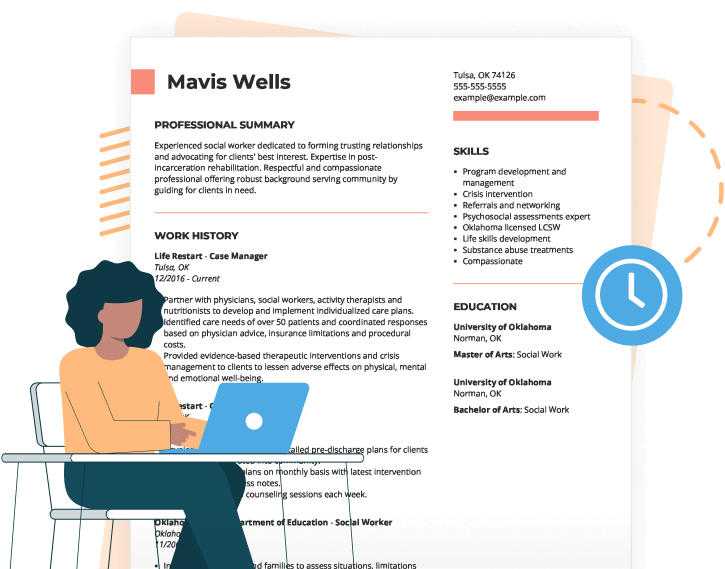Featured Resume Examples
Additional top-requested safety and security resume examples are for security officer, lifeguard and security manager. If you’re looking for a different job title, scroll on, we have dozens of great examples from which to peruse below.
Search Safety Security Jobs
Safety Security Resumes by Job Title
Find the resume example you need by browsing these specific Safety Security categories:
Security Roles (23)
Installation and Client Support Roles (1)
Safety Roles (30)
Cover Letter Examples for Safety Security Jobs
Job Outlook
Employment for safety and security officers is expected to grow 3% by 2029 according to the U.S. Bureau of Labor Statistics.
If you want to land a role in this steady industry it’s important that you have a resume that gets you noticed by hiring managers.
Check out our resume-writing tips below to be sure that you’re putting your best self forward.
3 Tips for Writing Safety and Security Resumes
Choose the right format for your resume.
As you know from your line of work, attention to detail can mean everything.
That’s why it’s really important that you present yourself in the strongest way possible by giving some thought to how you should organize your resume before you write it.
A resume’s organization is known as its format.
There are three common resume-format types: chronological, functional and hybrid.
The main difference between the three formats is where the primary focus is placed, whether it’s more weighted toward your skills or toward your work history.
Chronological formats are best for people with five or more years of experience because they put the emphasis on roles you’ve held, duties you’ve performed, and show a career arc. If you’ve already cut your teeth in the industry, use this format.
However, if you’re new to the industry or transferring from another line of work, you should choose a different format that is a better fit to your experience level.
Functional formats put greater emphasis on your skills and education which takes attention away from your inexperience. If you have less than two years’ experience as a safety and security professional, this format is perfect.
A hybrid format is a mix of the functional and chronological formats and gives a more even balance between your work history and skills. If you’ve worked for more than two years in safety and security, but less than five total, use this format.
Promote your skills.
Every job in the safety and security industry is going to be a bit different. But there are skills employers need across the board.
Try to include six-to-eight key skills that you possess on your resume.
Popular desired skills include:
- Attention to detail
- Authoritative presence
- Problem-solving
- Preventative measures
- Empathy
- Thoroughness
- Predictive anticipation
- Honesty
- Physical fitness
- Active listening
- Team-focused mindset
- Multitasking
- Heavy lifting
- Surveillance
- Integrity
- Patrolling
- Communication
- Consistency
- Customer service
- Dependability
- Crowd control
- CPR
- First-Aid
- Access management
- Calm under pressure
- Decision-making
- Physical aptitude
- Public safety
- Positive attitude
Read the job posting or ad carefully — the phrases and keywords listed are your best indication of exactly what the position needs in a candidate.
Show that you pay attention to detail by echoing back some of those key skills with the same phrasing that the employer used.
Use a template to make sure your resume looks amazing.
As you know from working in the safety and security industry, your attention to details can be what prevents accidents, mishaps and undesired outcomes.
So, when you submit your resume it’s important to show that you made an effort to ensure that your resume is easy-to-read and looks professional.
Which is why you should use a resume template.
A template is just a preformatted document created by a professional designer to be clear, professional, and to make creating a resume faster and easier.
All you have to do is select one that you like and input your personal information. You can save it in any format and then you’re ready to apply for jobs. It’s that easy.
JobHero has some great resume templates that you’re welcome to use.
Even better, JobHero features a Resume Builder that allows you to choose from a selection of templates and takes the automation a step further.
The builder suggests phrases to best-describe your work history. They’re even custom-tailored to the job that you’re applying for.
JobHero’s Resume Builder is like having a safety and security expert looking over your shoulder to give you good advice every step of the resume-writing journey.
FAQ
How much does a job in safety and security get paid?
Every role varies. For instance, security guards made an average salary of $34,190 in 2019 whereas lifeguards and other protective services made $23,570.
If you have a role that you’re very serious about, use our Resume Builder. It’s going to be the fastest and easiest way that you can show you’re a cut above the job competition.
What should I put on my resume for the safety and security industry?
One of the best ways that your resume can grab the attention of employers is by including as many numbers as possible to demonstrate the work you do.
Put these selling points of your safety and security resume in your skills and work experience sections. Those are the main spaces where you have to show employers that you’re the right person for the job, so incorporate some statistics.
Numbers will not only grab the attention of employers, they give a much better impression of what your work capacity looks like.
For example, a security guard could include figures to better convey the impact and scope of their work:
- Run the security operations for a local bank and trust averaging 50-100 clients per day
- Monitor 15 surveillance cameras
- Oversee four other security officers
- Prevented two security issues in 2020
Just keep in mind that part of what makes a good safety and security professional relies on your integrity, so don’t lie or embellish on these numbers. Be honest as lying on your resume will only come back to hurt you.
How do I list education on a safety and security resume?
Not all jobs in the safety and security industry require advanced education.
However, it’s standard practice to include education on any resume.
The protocol is to list any education you’ve had. But if you did attend college, you don’t need to list high school or anything prior.
When you include it, give the name of the school, its city/state and the degree you earned (if applicable) with your major.
It might look something like this:
Hunter College New York, NY
BA, English
While it used to be common to include the year that you graduated, it’s become discouraged to mention dates because it gives an indication of your age. That can lead to hiring bias. So, only include the dates you attended if you did not complete the degree.
If you have a license to be a security guard, you should include that in your resume under a Licenses and Certifications section.
What kind of work experience should I put on a safety and security resume?
If possible, keep all the work experience you include in a resume focused on your safety and security experience.
The closer your work history aligns with the position that you’re applying for, the more that managers are going to consider you.
Try to include details about your previous roles that you believe will be useful for the position that you’re applying to.
That means if you’re new to the security and safety industry, try to include relevant work from other fields. Anything that involves loss-control, public engagement, customer service or leadership is good to address.
Should I include a cover letter with my safety and security resume?
Yes, it’s in your best interest to include a cover letter when you submit your resume, even if it’s not mentioned in the job post.
Don’t miss this chance to really sell yourself and what safety and security skills you bring to the table.
Introduce yourself, and explain what motivates you as an employee.
To help you write your own great letter, check out JobHero’s safety and security cover letter examples page. You’ll see how like-minded professionals have advertised their skills, and it’ll help you get inspired.
If you want more information, JobHero also has a step-by-step guide on how to write a cover letter that will break each section of the cover letter down for you so that you know exactly what to say.







